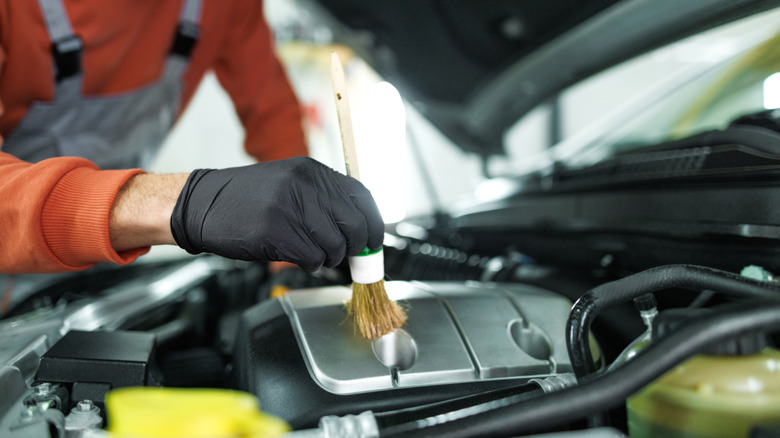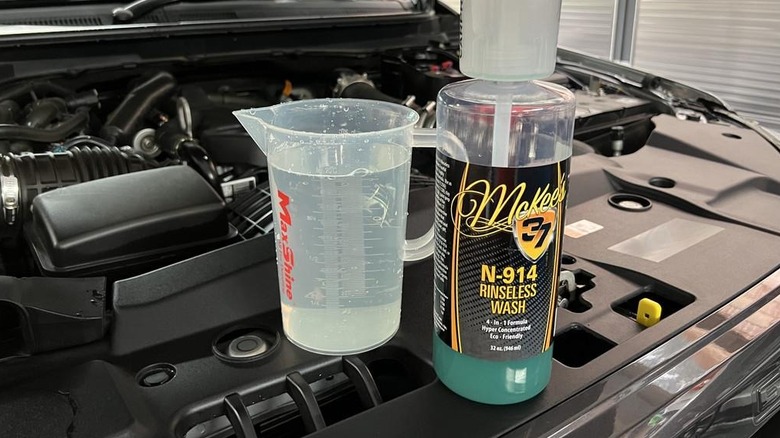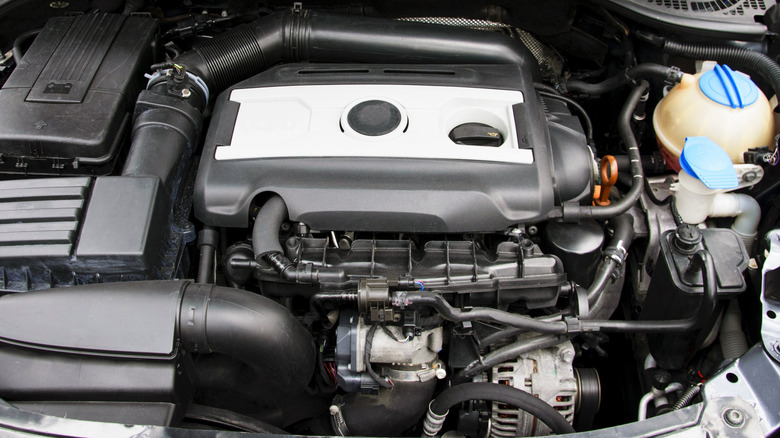What Is A Waterless Engine Wash And Is It Safe To Do At Home?
An important part of car maintenance is having a clean engine. Keeping the engine bay clean can helps ensure the car operates at its optimal performance by identifying potential issues such as corrosion, oil leaks, air flow blockage, and worn-out parts otherwise covered by dirt or grime. A normal wash for a car and the engine involves using water and soap, but there is an alternative method to clean the engine that does not require water. Depending on the engine or vehicle, it could be a preferred option to water and soap.
A waterless engine wash instead uses special cleaning chemicals and solutions to remove the built-up dirt and grime. This method works because of the properties that the cleaning chemicals contain — a combination of surfactants — that decrease the surface tension between liquids and solids, detergents, and in some cases, polymers. These work together to clean the surfaces and leave a protective coat, similar to car wax. Compared to using soap and water, using a waterless engine wash has several advantages that make it an attractive option for cleaning; including the simplicity of how it is done, the relatively short time it takes to complete, and eliminating the risk of damaging the electrical components of the engine when using water.
Chemical cleaning power, without any water
Is a waterless engine wash safe to do at home? Yes, but it is important to follow the usage and application instructions specified by the product manufacturer and observe safety precautions, including wearing protective gear to achieve the best result. A waterless engine wash is straightforward, and the materials needed are simple and reasonably priced, including rubber gloves, protective covers (plastic bags will do), a soft bristle toothbrush, detailing brushes, the chemical solution, and microfiber towels.
To start the process, the car must be parked with the handbrake engaged, and wait until the car cools down after driving to avoid burns from contact with hot metal. Next, the sensitive areas of the engine must be covered using plastic bags to protect from chemical exposure, such as battery terminals, ignition wiring, air intake, and alternator. Waterless engine wash products normally come in a spray bottle, and if this type will be used, the next step is to spray the product on the surfaces to be cleaned, and wait for a few minutes for the solution to be absorbed by the dirt. Then, use the microfiber cloth to wipe the surfaces clean, and continue wiping as needed to remove any streaks.
For products that don't have a spray nozzle, pour a minimum amount of the solution on the microfiber cloth and repeat the previous steps. Lastly, for areas that are hard to reach, use the brushes to scrub the dirty nooks and crannies around the engine making sure that each area is scoured thoroughly.
Ideal Alternative for Cleaning Your Engine
A waterless engine wash is convenient and results in a great clean for the engine, but it is also important to remember that it has limitations, and may have risks if not used properly. Similar to any cleaning routine, the periodic application of the process should be done to maintain the clean state of the engine, as this is not a one-and-done fix for cleaning. For situations requiring more rigorous cleaning, like engines that have heavy dirt or mud build-up, it is recommended to use a light wash of soap and water first to loosen the particles before using a waterless engine wash.
Lastly, because of its waterless nature, the use of the cleaning solutions may leave residue on the applied surfaces that can allow dust and dirt to accumulate later on. In terms of time and expense, a waterless engine wash can be more costly, as the chemical solution is more expensive than regular car soap, and the time it takes to complete the process is more intensive. Waterless engine washes provide a great alternative to the hose, bucket, and foam routine, but one must consider both its cost, benefits, and risks to decide if this is the ideal option to use for their needs.


